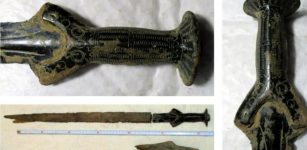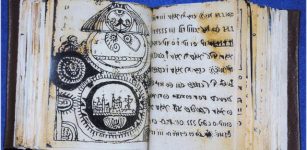Pazyryk Carpet Found In Scythian Tomb Considered The Oldest Carpet In The World
A. Sutherland - AncientPages.com - In 1949, Russian archeologist Sergei Rudenko made an extraordinary discovery while excavating burial mounds and a Scythian prince's tomb in southern Siberia.
 Pazyryk Carpet. Image source
Pazyryk Carpet. Image source
The place of the discovery was the so-called Pazyryk Valley, Altai Territory, in the region of the Bolshoy Ulagan River. In his excavations, Rudenko focused on the ancient history of weaving.
The tomb of a Scythian Prince dating back to 500 B.C. contained many treasures, and among them was the Pazyryk Carpet, measuring 183cm x 200cm and made by skilled craftsmen. It was created by using the traditional Turkish knotting system. The ancient rug is finely knotted with an average of 200 to 270 symmetrical knots to the square inch.
The tradition of making this kind of carpet originated from the nomadic Turkish tribes that occupied central Asia two millennia ago. However, this unbroken tradition of rug-making survived alongside more modern practices.
The carpet's decoration is vibrant and varied. The central part is covered with 24 cross-shaped figures, each consisting of 4 stylized lotus buds. This composition is framed by a border of griffins, followed by another one of 24 fallow deer. The most expansive of these two borders contains 28 figures of men on horseback and dismounted.
Credit: Hermitage Museum - Public Domain
Naturally, the carpet's once bright yellows, blues, and reds are not visible today, but initially, the rug must have displayed a beautifully glowing range of colors.
The Pazyryk carpet was made using the technique of the symmetrical double knot, the so-called Turkish knot, which means - 3600 knots per 1 dm2, so the whole carpet has more than 1,250,000 knots, and therefore this carpet pile is dense.
The origin of this unique Pazyryk carpet is not entirely known. Experts suggest that it may have a connection to Iran, but it perhaps was made somewhere in Central Asia thanks to the contacts of ancient people of the Altai Mountains with those from Iran and the Near East region.
Interestingly, the beautiful Pazyryk rug may represent only a copy of the original Persian piece of art.
The Pazyryk culture was a Scythian nomadic Iron Age archaeological culture of Iranian origin that lived from the 6th to 3rd centuries BC. Unearthed artifacts and mummified humans found in the Siberian permafrost in the Altay (Altai) Mountains, Kazakhstan, and Mongolia made their identification possible.
Another Pazyryk rug. Circa 400 BC. Hermitage Museum - Image source - Schreiber - Public Domain
The Pazyryk's mummies were buried in long barrows (or kurgans), similar to the Scythian tomb mounds in Ukraine. Many artifacts and human remains were found at this location.
The culture flourished and benefited from the many trade routes and caravans of merchants passing through the area.
Ancient cultures flourished and disappeared for thousands of years in the Altai region, Siberia. Archaeologists have excavated the old burial complexes of the Pazyryk culture that existed in the Altai region about 2,500 years ago, from the end of 600 BC to the beginning of 200 BC.
Excavations revealed several skulls that offer evidence of sophisticated ancient surgical technologies and tombs with the bodies of horses and one with an embalmed body of a man whose body was decorated with tattoos depicting animal motifs. The remarkable textiles recovered from the Pazyryk burial tombs include the Pazyryk Carpet, pieces of woven Persian fabric, and the oldest embroidered Chinese silk.
Updated on May 11, 2024
Written by – A. Sutherland - AncientPages.com Senior Staff Writer
Copyright © AncientPages.com All rights reserved. This material may not be published, broadcast, rewritten or redistributed in whole or part without the express written permission of AncientPages.com
Expand for referencesMore From Ancient Pages
-
 Lost Treasure Of King Atterdag Remains An Unsolved Ancient Mystery
Featured Stories | Jul 13, 2017
Lost Treasure Of King Atterdag Remains An Unsolved Ancient Mystery
Featured Stories | Jul 13, 2017 -
 Skaftö Wreck’s Cargo Gives New Answers About 15th Century Trade Routes
Archaeology | Oct 25, 2022
Skaftö Wreck’s Cargo Gives New Answers About 15th Century Trade Routes
Archaeology | Oct 25, 2022 -
 Hiding Tunnel Complex Dated To The Bar Kokhba Revolt Revealed Near The Sea of Galilee
Archaeology | Apr 23, 2024
Hiding Tunnel Complex Dated To The Bar Kokhba Revolt Revealed Near The Sea of Galilee
Archaeology | Apr 23, 2024 -
 Ancient Maya Reservoirs Can Solve Today’s Water Crises – Scientists Say
Archaeology | Oct 10, 2023
Ancient Maya Reservoirs Can Solve Today’s Water Crises – Scientists Say
Archaeology | Oct 10, 2023 -
 Rare 3,300-Year-Old Sword Accidentally Discovered In Jesenicko, Czech Republic
Archaeology | Nov 9, 2020
Rare 3,300-Year-Old Sword Accidentally Discovered In Jesenicko, Czech Republic
Archaeology | Nov 9, 2020 -
 The Iron Man In The Kottenforst And Other Puzzling Ancient Artifacts Of Unknown Origin And Purpose
Ancient Mysteries | Mar 10, 2014
The Iron Man In The Kottenforst And Other Puzzling Ancient Artifacts Of Unknown Origin And Purpose
Ancient Mysteries | Mar 10, 2014 -
 Rohonczi Codex Still Undeciphered – Is It The Most Secret Book Written In A Code?
Artifacts | May 30, 2014
Rohonczi Codex Still Undeciphered – Is It The Most Secret Book Written In A Code?
Artifacts | May 30, 2014 -
 Ancient Burials Shed New Light On Earliest Humans In Indonesia
Archaeology | Aug 25, 2022
Ancient Burials Shed New Light On Earliest Humans In Indonesia
Archaeology | Aug 25, 2022 -
 On This Day In History: Pueblo Indians Capture Santa Fe From The Spanish – On August 21, 1680
News | Aug 21, 2016
On This Day In History: Pueblo Indians Capture Santa Fe From The Spanish – On August 21, 1680
News | Aug 21, 2016 -
 Surprising Discovery Of Rare Turtle Statue Under Bayon Temple In Angkor, Cambodia
Archaeology | May 2, 2024
Surprising Discovery Of Rare Turtle Statue Under Bayon Temple In Angkor, Cambodia
Archaeology | May 2, 2024 -
 Evidence Of Legendary Ancient Great Flood In China May Re-Write History
Chinese Mythology | Aug 5, 2016
Evidence Of Legendary Ancient Great Flood In China May Re-Write History
Chinese Mythology | Aug 5, 2016 -
 Fragment Of A Fine Marble Statuette Of Heracles Found In Jezreel Valley, Israel
Archaeology | May 24, 2023
Fragment Of A Fine Marble Statuette Of Heracles Found In Jezreel Valley, Israel
Archaeology | May 24, 2023 -
 Rare Animal-Shaped Mounds Discovered In Peru
Archaeology | Apr 2, 2012
Rare Animal-Shaped Mounds Discovered In Peru
Archaeology | Apr 2, 2012 -
 Extraordinary Discovery Of First Viking Tower In Viborg, Denmark Re-Writes Viking History
Archaeology | Jan 30, 2017
Extraordinary Discovery Of First Viking Tower In Viborg, Denmark Re-Writes Viking History
Archaeology | Jan 30, 2017 -
 DNA Of Nine 13th Century Crusaders Provides A Glimpse Into Soldiers’ Life And Death
Archaeology | Apr 22, 2019
DNA Of Nine 13th Century Crusaders Provides A Glimpse Into Soldiers’ Life And Death
Archaeology | Apr 22, 2019 -
 ‘Supernatural’ Sized Daughter Of Thera: Rare Masterpiece Of Greek Antiquity Revealed To The Public
Artifacts | Oct 1, 2022
‘Supernatural’ Sized Daughter Of Thera: Rare Masterpiece Of Greek Antiquity Revealed To The Public
Artifacts | Oct 1, 2022 -
 Countless Artifacts, Structures And Roads Discovered In Ancient City Of Aigai, Turkey
Archaeology | May 16, 2022
Countless Artifacts, Structures And Roads Discovered In Ancient City Of Aigai, Turkey
Archaeology | May 16, 2022 -
 Ancient Hebrew Inscription Reveals Location Of Biblical Mount Sinai
Archaeology | Nov 21, 2019
Ancient Hebrew Inscription Reveals Location Of Biblical Mount Sinai
Archaeology | Nov 21, 2019 -
 Magnificent Hochdorf Chieftain’s Grave – Resting Place Of The Celtic Tutankhamun
Featured Stories | Aug 19, 2019
Magnificent Hochdorf Chieftain’s Grave – Resting Place Of The Celtic Tutankhamun
Featured Stories | Aug 19, 2019 -
 Vimanas – Flying Machines Soaring Through Ancient Sky Of India
Ancient Mysteries | May 27, 2014
Vimanas – Flying Machines Soaring Through Ancient Sky Of India
Ancient Mysteries | May 27, 2014


